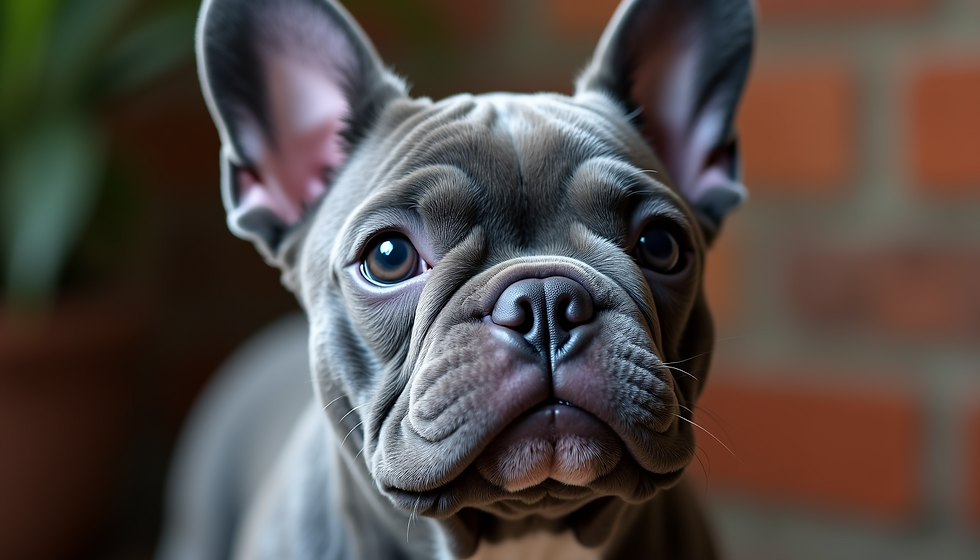A Brief History of French Bulldogs: From Origins to Today
- mrposani
- Sep 1
- 4 min read
French Bulldogs are one of the most beloved dog breeds worldwide. Their charming personalities and distinctive looks have made them a favorite companion for many. But where did these little dogs come from? How did they evolve into the breed we know today? This article explores the fascinating journey of French Bulldogs, tracing their roots and development through time.
The Origins of French Bulldogs
The story of French Bulldogs begins in the 1800s. They are descendants of small bulldogs brought to France by English lace workers during the Industrial Revolution. These workers migrated from Nottingham, England, to the city of Nottingham, France, seeking better job opportunities. They brought their small bulldogs with them as companions.
In France, these dogs were bred with local ratters and other small breeds. The goal was to create a dog that was both a good companion and a skilled hunter of small vermin. Over time, this crossbreeding led to the development of the French Bulldog as a distinct breed.
The breed quickly gained popularity in Paris, especially among the working class and artists. Their compact size and friendly nature made them ideal city dogs. They were often seen in cafes and on the streets, becoming a symbol of Parisian life.

French Bulldog History: The Breed’s Rise to Fame
The rise of the French Bulldog continued into the late 19th and early 20th centuries. The breed was officially recognized by the French Kennel Club in 1898. Around the same time, the American Kennel Club also began to acknowledge the breed.
French Bulldogs became popular among the upper class and celebrities. Their unique bat-like ears and muscular build set them apart from other small breeds. They were often featured in art and literature, further cementing their status as fashionable pets.
During this period, breeders focused on refining the breed’s characteristics. They aimed to maintain the dog’s friendly temperament while enhancing its physical traits. This included the signature flat face, broad chest, and distinctive ears.
The breed’s popularity spread beyond France and the United States, reaching other parts of Europe and the world. Today, French Bulldogs are one of the most popular dog breeds globally.
What Did the Original French Bulldogs Look Like?
The original French Bulldogs were quite different from the modern version. Early French Bulldogs were smaller and had a more varied appearance. Their ears were not always the iconic bat shape we see today. Instead, some had rose-shaped ears, similar to their English Bulldog ancestors.
Their faces were less flat, and their bodies were leaner. The coat colors were also more diverse, including brindle, fawn, and pied patterns. These early dogs were bred more for function than form, focusing on their ability to hunt and be good companions.
Over time, selective breeding emphasized the traits that are now standard. The bat ears became a defining feature, and the body became more muscular and compact. These changes helped the breed adapt to urban living and made them more appealing as pets.

The French Bulldog in Modern Times
Today’s French Bulldogs are known for their affectionate nature and playful personality. They are excellent companions for families, singles, and seniors alike. Their small size makes them suitable for apartment living, and their low exercise needs fit well with busy lifestyles.
However, modern French Bulldogs also face some health challenges. Their flat faces can cause breathing difficulties, and their compact bodies may lead to joint problems. Responsible breeding practices are essential to minimize these issues.
If you are considering adopting a French Bulldog, it is important to choose a reputable breeder. Look for breeders who prioritize health testing and ethical breeding standards. Regular veterinary care and a healthy diet will also help keep your French Bulldog happy and thriving.

Why Learn About French Bulldog History?
Understanding the french bulldog history helps owners appreciate the breed’s unique traits and needs. Knowing where these dogs come from can guide better care and training practices.
For example, knowing their origins as companion and working dogs explains their social nature and intelligence. It also highlights the importance of mental stimulation and social interaction for their well-being.
Moreover, awareness of the breed’s health issues encourages responsible ownership. It helps potential owners make informed decisions and advocate for better breeding standards.
By learning about the French Bulldog’s past, you can better enjoy their present and contribute to their future.
Caring for Your French Bulldog Today
To keep your French Bulldog healthy and happy, consider these practical tips:
Regular Vet Visits - Schedule check-ups to monitor breathing, skin, and joint health.
Balanced Diet - Feed high-quality dog food appropriate for their size and activity level.
Exercise - Provide moderate daily exercise, such as short walks and playtime.
Socialization - Introduce your dog to different people and environments early on.
Grooming - Brush their coat weekly and clean facial folds to prevent infections.
Temperature Control - Avoid extreme heat or cold, as French Bulldogs are sensitive to temperature changes.
By following these guidelines, you can ensure your French Bulldog lives a long, joyful life.
French Bulldogs have come a long way from their humble beginnings. Their rich history and unique characteristics make them a truly special breed. Whether you are a current owner or simply a fan, understanding their story adds depth to your appreciation of these charming dogs.








Comments